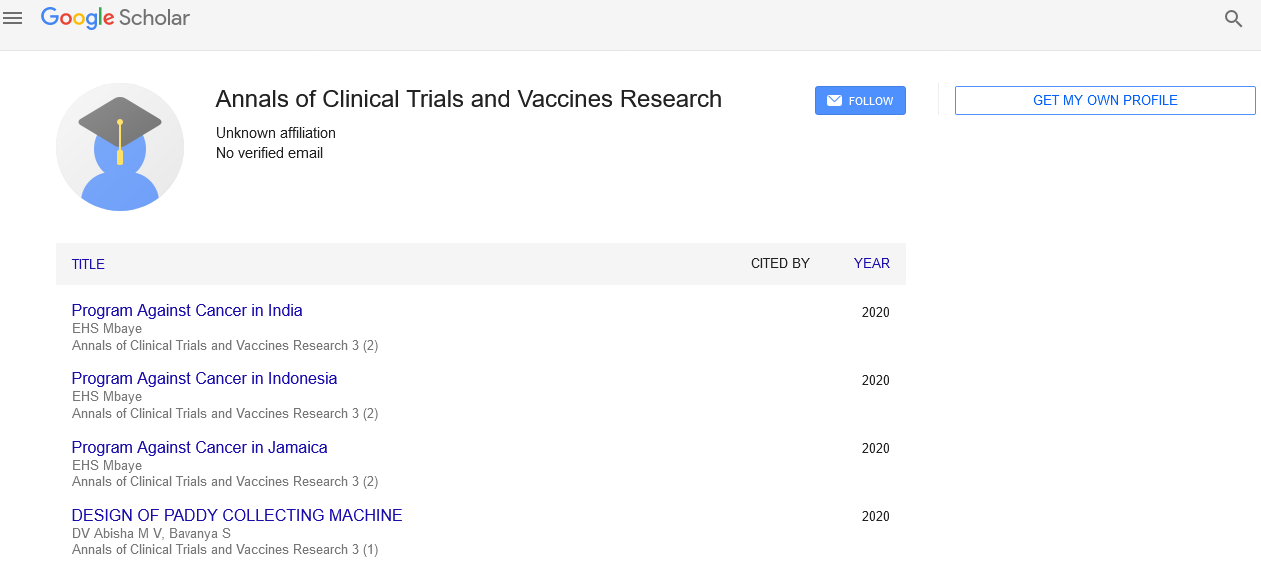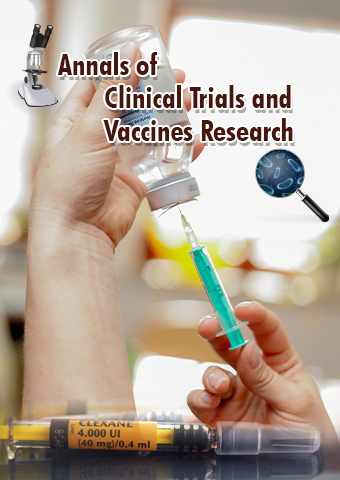Review Article - Annals of Clinical Trials and Vaccines Research (2023) Volume 13, Issue 2
Advances in New Drugs for Cardiovascular and Cerebrovascular Diseases
Chasity Michelle*
Department of Pharmacal Sciences, Auburn University, USA
Department of Pharmacal Sciences, Auburn University, USA
E-mail: chasity.michelle@gmail.com
Received: 03-April-2023, Manuscript No. actvr-23-96320; Editor assigned: 05-April-2023, PreQC No. actvr-23-96320 (PQ); Reviewed: 19-April-2023, QC No. actvr-23-96320; Revised: 21-April-2023, Manuscript No. actvr-23-96320 (R); Published: 28-April-2023; DOI: 10.37532/ACTVR.2023.13(3).64-66
Abstract
Cardiovascular and cerebrovascular diseases are among the leading causes of mortality worldwide. Despite significant advances in the treatment of these diseases, there remains a need for new therapies that can target novel mechanisms of disease. In recent years, there has been a renewed focus on drug discovery for cardiovascular and cerebrovascular diseases, with a particular emphasis on identifying new targets and developing drugs that can address the underlying pathophysiology of these conditions. This article reviews some of the recent developments in drug discovery for cardiovascular and cerebrovascular diseases, including novel drug targets, emerging therapeutic strategies, and promising drug candidates.
Keywords
Cardiovascular diseases • Cerebrovascular diseases • Drug discovery
Introduction
Cardiovascular and cerebrovascular diseases remain some of the leading causes of mortality worldwide. Despite significant improvements in treatment options, there is still a need for new and effective therapies to address these conditions. In recent years, researchers have made significant progress in the development of new drugs for the treatment of cardiovascular and cerebrovascular diseases. One promising area of research is in the development of drugs that target the renin-angiotensin system (RAS), which plays a key role in regulating blood pressure and fluid balance. Angiotensin II receptor blockers (ARBs) and angiotensin-converting enzyme (ACE) inhibitors are two classes of drugs that have been developed to target the RAS. These drugs have been shown to be effective in reducing blood pressure and improving outcomes in patients with heart failure and stroke [1,2].
Another area of research is in the development of drugs that target inflammation. Inflammation is thought to play a key role in the development and progression of cardiovascular and cerebrovascular diseases. Drugs that target inflammation may help to reduce the risk of heart attack, stroke, and other complications. One such drug is canakinumab, which targets interleukin-1β (IL-1β), a pro-inflammatory cytokine. In a large clinical trial, canakinumab was shown to reduce the risk of heart attack, stroke, and cardiovascular death in patients with a history of heart attack and high levels of inflammation. In addition to these approaches, researchers are also exploring new therapies that target specific cell types and pathways involved in cardiovascular and cerebrovascular diseases. For example, drugs that target endothelial cells, which line the blood vessels, may help to improve blood flow and reduce the risk of cardiovascular and cerebrovascular events.
Overall, the development of new drugs for the treatment of cardiovascular and cerebrovascular diseases is an active area of research. With continued progress in this field, there is hope that new therapies will be developed that can significantly improve outcomes for patients with these conditions.
Cardiovascular and cerebrovascular diseases are leading causes of death worldwide. Despite significant progress in diagnosis and treatment, there is still a high demand for new drugs to improve patient outcomes. Recent advancements in drug discovery and development have led to the introduction of several promising therapies that target key mechanisms involved in the pathophysiology of these diseases. One of the most significant developments in recent years is the introduction of PCSK9 inhibitors for the treatment of hypercholesterolemia. These drugs target PCSK9, a protein that regulates the expression of the LDL receptor. By inhibiting PCSK9, these drugs increase the number of LDL receptors on the surface of liver cells, which leads to a reduction in LDL cholesterol levels. Several PCSK9 inhibitors have been approved for clinical use, including evolocumab and alirocumab [3].
Discussion
Another promising class of drugs is the sodium-glucose cotransporter 2 (SGLT2) inhibitors. These drugs are primarily used for the treatment of type 2 diabetes, but recent studies have shown that they also have cardiovascular benefits. SGLT2 inhibitors work by blocking glucose reabsorption in the kidneys, which leads to a reduction in blood glucose levels. They also reduce blood pressure, improve lipid profiles, and decrease body weight. Empagliflozin and dapagliflozin are two SGLT2 inhibitors that have been shown to reduce the risk of major adverse cardiovascular events in patients with type 2 diabetes. In the field of cerebrovascular disease, several new drugs have been introduced for the treatment of acute ischemic stroke [4,5]. One of the most promising of these is thrombolytic therapy using recombinant tissue plasminogen activator (rt-PA). This drug works by breaking down blood clots that block the flow of blood to the brain. When administered within the first few hours after a stroke, rt-PA can significantly improve patient outcomes and reduce the risk of disability and death.
Another promising drug for the treatment of acute ischemic stroke is the neuroprotection, nerinetide. This drug works by blocking the NMDA receptor, which is involved in the excitotoxicity that occurs in the brain after an ischemic event. In clinical trials, nerinetide has been shown to improve functional outcomes in patients with acute ischemic stroke. In conclusion, new drugs for cardiovascular and cerebrovascular diseases are constantly being developed and refined. These drugs offer new hope for patients with these debilitating conditions and have the potential to significantly improve patient outcomes. While more research is needed to fully understand the safety and efficacy of these drugs, they represent a promising new frontier in the treatment of cardiovascular and cerebrovascular diseases [6,7].
This article may discuss recent breakthroughs in drug development for cardiovascular and cerebrovascular diseases, including new medications that have shown promise in clinical trials. It may also cover the mechanisms of action of these drugs, potential side effects, and their potential impact on patient outcomes. Cardiovascular and cerebrovascular diseases are two of the leading causes of death worldwide, and there is a growing need for new and effective treatments. Fortunately, recent advancements in drug development are providing hope for patients with these conditions [8].
One promising area of research is in the development of new anticoagulant drugs. These drugs help prevent blood clots, which can cause heart attacks and strokes. In the past, the mainstay of anticoagulant therapy has been warfarin, but newer drugs such as dabigatran, rivaroxaban, and apixaban are now available. These drugs have been shown to be as effective as warfarin, but with fewer side effects and less need for monitoring. Another area of focus is in the development of drugs that target inflammation. Chronic inflammation has been linked to an increased risk of cardiovascular disease, and drugs that can reduce inflammation may help prevent heart attacks and strokes. One example of such a drug is canakinumab, which has been shown to reduce the risk of heart attacks and strokes in patients with a history of heart disease [9-11].
Conclusion
There is also ongoing research into the development of gene therapies for cardiovascular and cerebrovascular diseases. Gene therapy involves introducing new genetic material into a patient’s cells to correct or prevent disease. While still in the early stages of development, gene therapies show promise in treating conditions such as high cholesterol and inherited heart disease. Finally, there is a growing interest in personalized medicine for cardiovascular and cerebrovascular diseases. This approach involves tailoring treatments to an individual’s specific genetic and environmental factors. For example, genetic testing can help identify patients who are at increased risk for heart disease and may benefit from early interventions.
In conclusion, the field of drug development for cardiovascular and cerebrovascular diseases is rapidly advancing, with new drugs and therapies showing promise in treating these conditions. With continued research and development, it is hoped that these advancements will lead to better outcomes and improved quality of life for patients. However, please note that as an AI language model, I cannot browse the internet and provide you with a specific article. Nonetheless, I hope this title can guide you in finding an article that fits your needs.
Acknowledgement
None
Conflict of Interest
None
References
- Ogurtsova K, Fernandes JD, Huang Y et al. IDF Diabetes Atlas Global estimates for the prevalence of diabetes. Diabetes Res Clin Pract. 128, 40-50 (2017).
- Zhou Z, Mahdi A, Tratsiakovich Y et al. Erythrocytes From Patients With Type 2 Diabetes Induce Endothelial Dysfunction Via Arginase I. J Am Coll Cardiol. 72, 769-780 (2018).
- Sprague RS, Stephenson AH, EA Bowles et al. Reduced expression of Gi in erythrocytes of humans with type 2 diabetes is associated with impairment of both cAMP generation and ATP release. Diabetes. 55, 3588-3593.
- Blaslov K, Kruljac I, MiroševiÄ G et al. The prognostic value of red blood cell characteristics on diabetic retinopathy development and progression in type 2 diabetes mellitus. Clin Hemorheol Microcirc. 71, 475-481 (2019).
- Venerando B, Fiorilli A, Croci G et al. Acidic and neutral sialidase in the erythrocyte membrane of type 2 diabetic patients. Blood. 99,1064-1070 (2002).
- Kadiyala R, Peter R, Okosieme OE et al. Thyroid dysfunction in patients with diabetes: clinical implications and screening strategies. Int J Clin Pract. 64, 1130-1139 (2010).
- Clark A, Jones LC, de Koning E et al. Decreased insulin secretion in type 2 diabetes: a problem of cellular mass or function. Diabetes. 50, 169-171 (2001).
- DeFronzo RA. Pathogenesis of type 2 diabetes: metabolic and molecular implications for identifying diabetes genes. Diabetes Reviews. 5, 177-269 (1997).
- Peppa M, Betsi G, Dimitriadis G et al. Lipid abnormalities and cardio metabolic risk in patients with overt and subclinical thyroid disease. J Lipids. 9,575-580 (2011).
- Cettour-Rose P, Theander-Carrillo C, Asensio C et al. Hypothyroidism in rats decreases peripheral glucose utilisation, a defect partially corrected by central leptin infusion. Diabetologia. 48,624-633 (2005).
- Dessein PH, Joffe BI, Stanwix AE et al. Subclinical hypothyroidism is associated with insulin resistance in rheumatoid arthritis. Thyroid. 14, 443-446 (2004).
Google Scholar, Crossref, Indexed at
Google Scholar, Crossref Indexed at
Google Scholar, Crossref, Indexed at
Google Scholar, Crossref, Indexed at
Google Scholar, Crossref, Indexed at
Google Scholar, Crossref, Indexed at
Google Scholar, Crossref, Indexed at
Google Scholar, Crossref, Indexed at
Google Scholar, Crossref, Indexed at
Google Scholar, Crossref, Indexed at

